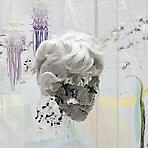David Altmejd
March 18 – April 23, 2011
Main Gallery
-
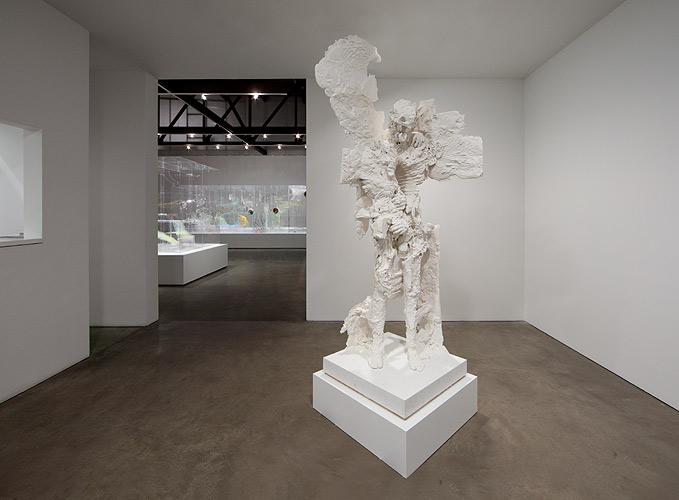
DAVID ALTMEJD
Untitled 4 (The Watchers)
2011
plaster, wood, foam, burlap
89 x 28 x 28 inches
(226.1 x 71.1 x 71.1 cm)
overall including base:
99 x 32 x 32 inches
(251.5 x 81.3 x 81.3 cm)
ARG# AD2011-008 -

DAVID ALTMEJD
The Vessel
2011
Plexiglas, chain, plaster, wood, thread, wire, acrylic paint, epoxy resin, epoxy clay, acrylic gel, granular medium, quartz, pyrite, assorted minerals, adhesive, wire, pins, needles
102 1/2 x 244 x 86 1/2 inches
(260.4 x 619.8 x 219.7 cm)
ARG# AD2011-002 -

DAVID ALTMEJD
The Architect 1
2011
plaster, wood, foam, burlap, laytex paint
dimensions variable
ARG# AD2011-004 -
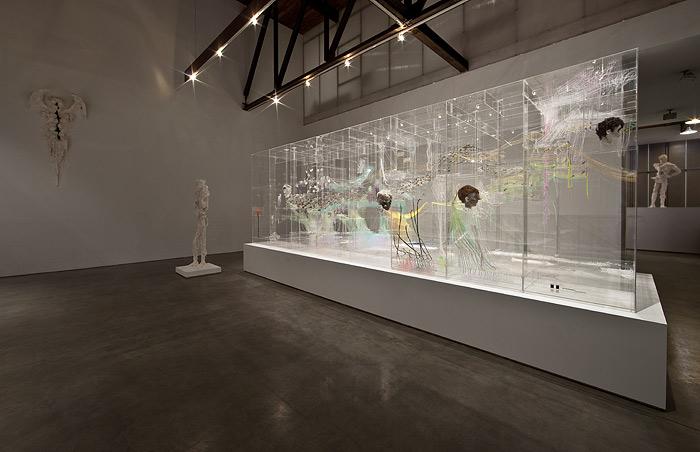
-
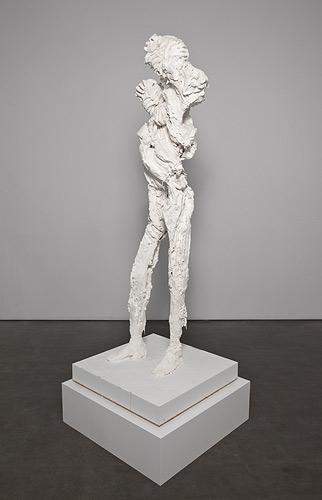
DAVID ALTMEJD
Untitled 3 (Bodybuilders)
2011
plaster, wood, foam, burlap
75 x 28 x 28 inches
(190.5 x 71.1 x 71.1 cm)
overall including base:
85 x 32 x 32 inches
(215.9 x 81.3 x 81.3 cm)
ARG# AD2011-007 -

DAVID ALTMEJD
The Swarm
2011
Plexiglas, chain, metal wire, thread, acrylic paint, epoxy resin, epoxy clay, acrylic gel, granular medium, synthetic hair, plaster, foam, sand, quartz, pyrite, amethyst, assorted minerals, adhesive, wire, pins, needles
102 1/2 x 244 x 84 1/2 inches
(260.4 x 619.8 x 214.6 cm)
ARG# AD2011-003 -
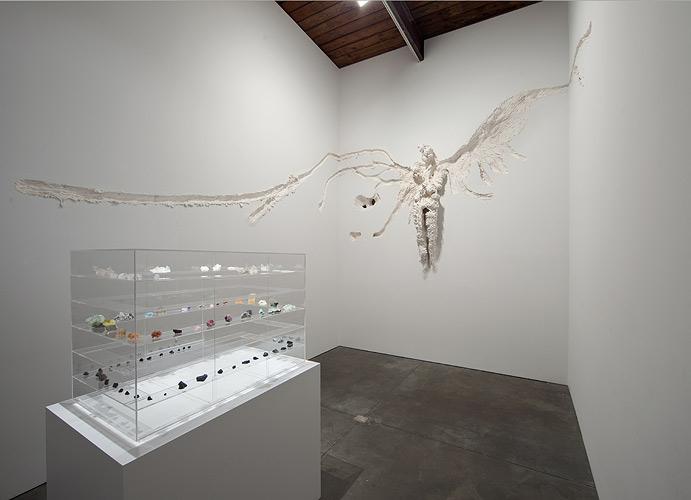
-
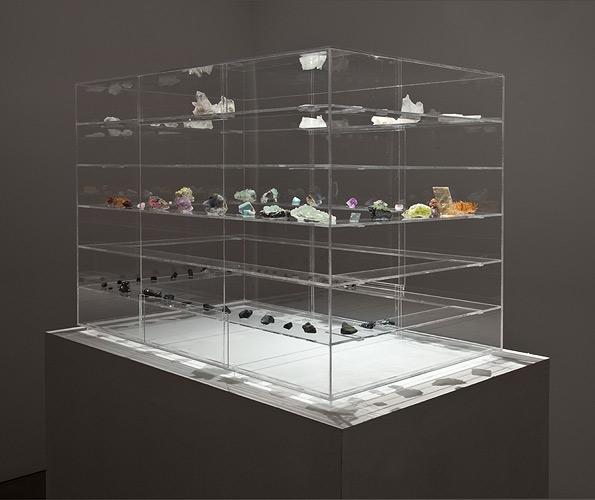
DAVID ALTMEJD
Spectre
2011
Plexiglas, amethyst, amazonite, apophyllite, aragonite, black tourmaline, celestite, fluorite, hematite, dolomite, optical calcite, sulfur, selenite, spessartite garnet, stibnite, raw tourmaline, rose quartz, quartz, peridot in basalt matrix, peridot
29 x 40 x 25 inches
(73.7 x 101.6 x 63.5 cm)
overall with base:
66 x 46 x 31 inches
(167.6 x 116.8 x 78.7 cm)
ARG# AD2011-009 -

DAVID ALTMEJD
Untitled 2 (Bodybuilders)
2011
plaster, wood, foam, burlap
71 x 28 x 28 inches
(180.3 x 71.1 x 71.1 cm)
overall including base:
81 x 32 x 32 inches
(205.7 x 81.3 x 81.3 cm)
ARG# AD2011-006 -

DAVID ALTMEJD
Untitled
2011
epoxy clay, plaster, glass eyes, synthetic hair, wire, quartz, assorted minerals, acrylic paint, glitter
7 3/4 x 8 x 14 inches
(19.7 x 20.3 x 35.6 cm)
ARG# AD2011-010
David Altmejd will present two extraordinary new bodies of work in his third solo exhibition with the gallery. Two large Plexiglas sculptures of an unprecedented scale for the artist share the space with a more ethereal group of works. These Plexiglas structures contain entire landscapes that are immensely and painstakingly detailed. Their scale and composition both encourage a close reading of details and yet purposefully disallow the viewer to grasp the whole all at once. For the first time, Altmejd will intervene into the architecture of the space with large scale sculptures scraped out of and embedded within the walls of the gallery. Just as the Plexiglas works represent a material shift from the exterior surface to the interior structure, between the inside and the outside, the embedded plaster sculptures turn space itself into an analogue of Altmejd's investigation into notions of interiority and exteriority in his practice. As definitions between inside and outside become blurred, Altmejd shows them at once to be both malleable distinctions and part of a continuum. At stake in these works is the fantasy of unity and containment. Just as Altmejd has shown how bodies can be so violently acted upon by interior and exterior forces, in his work the apparent neutrality and solidity of architecture is shown to be unable to contain the overflow of ideologies and agendas embedded within—the body of the space bursting and the walls becoming a porous membrane.
While these bodies of work seem so clearly new in Altmejd's practice, they are also visions into the whole of his existing oeuvre. It is the strength and uniqueness of Altmejd's visual vocabulary that allows him the freedom to develop his work in such radical ways. The bravery with which Altmejd approaches the invention of new bodies of work is an organic extension of the larger conceptual concerns at the core of his practice. Altmejd's work makes evident how growth and transformation is only possible from decay and how a sense of a work being alive is perceived most fully when beauty is contrasted with the abject. Set against a prevailing cultural and political headwind valuing tradition, certainty, and stasis, Altmejd's work is a physical manifestation of an ideology of growth, change, and perpetual movement.
In Altmejd's work, chaos and order are shown to be two related states that can generate each other. In one Plexiglas work titled The Vessel 2011, plaster casts of arms and hands form swanlike shapes, with the hands holding (or throwing) beaks formed from modeling clay. The hands collectively take on the shape of a cresting wave and embody the latent potential of that form as though tension is held in a perpetual climax. The line between violence and protection becomes blurred, as does our desire for one over the other. Seen from the front, the composition appears nearly symmetrical, but upon closer inspection each side has been crafted individually with the symmetry of the structure becoming displaced by the subjectivity of individual choices. Conversely, The Swarm 2011 is seemingly without symmetry and yet the accumulation of choices and decisions begins to suggest an ordered, planned composition. The Swarm is filled with hundreds of constructed bees, ants and hand-painted thread simultaneously evocative of a body's nervous system and natural forms like roots. Indeed, Altmejd's work mimics the complexity achieved in the natural world through the continual layering of elements and structures built up over millennia. Whether Altmejd begins from a point of symmetry or from a point of disorder, his works are ultimately shaped by the individual choices made at each point of construction. These works suggest the organic logic of the crowd where individual decisions can collectively generate a more intelligent whole.
Large plaster sculptures embedded within the gallery walls extend the scope of the exhibition to fill the entire space. Standing figures, also in plaster, are arrayed through the gallery and seem to have emerged from the walls and create a progression from the entrance, through the main gallery, and into Gallery 3, which features the embedded work Architect 2, 2011 that spans three of the gallery's walls. Both the wall sculptures and the embedded sculptures feature cast hands appearing to tear the works apart from within and leaving deep grooves in their wake. The surface and structure of these works are both a trace of the artist's process and a vision of a self-generating form. The hands are both pulling the form apart and building it up. Faces become replaced by hands or are covered in ears and each of the figures has holes and voids disrupting the unity of the body. Altmejd's works suggest a kind of infinite lineage with each work both exploring a particular idea and contributing to the opening of another. Rather than creating terminal artworks, complete and ossified, Altmejd's works are manifestations of objects that are always transforming and forever open. Rather than crafting puzzles for viewers to solve, Altmejd generates structures and landscapes to inhabit.
David Altmejd (b. 1974 in Montreal) lives and works in New York. Altmejd will be presenting a solo exhibition at the Brant Foundation Art Study Center, Greenwich in the late fall of 2011 and in May he will debut 'Twilight Tale', a lyrical visual fairytale with composer-performer Pierre Lapointe at the Galerie de l'UQAM in Montreal. Recent solo exhibitions include Le Magasin Centre National d'Art Contemporain in Grenoble, Gallery Met at the Metropolitan Opera House, New York and in the Fundacion La Caixa Museum in Barcelona. Last year he participated in the group exhibitions at the New Museum of Contemporary Art, New York; the Guggenheim Museum, New York; P.S. 1 Contemporary Art Center, New York; Dallas Museum of Art, Dallas and The Museum of Contemporary Art, Los Angeles. In 2009 he was awarded Canada's pre-eminent Sobey Award for contemporary Canadian art.
For more information and images, please contact Jessica Eckert, j.eckert@rosengallery.com, or Renee Reyes, r.reyes@rosengallery.com.
David Altmejd
David Altmejd is known for his intricate and highly worked room-size installations and sculptures. Seamlessly moving between a variety of aesthetic modes – from an almost ascetic minimalism in works employing plaster and mirror to works teeming with accumulations of crystals, gold chain, thread, taxidermied birds and animals, among other objects -- Altmejd’s work offers beautifully wrought meditations on the cycles of life and death, interiority and exteriority, sexuality, and spirituality. In the most comprehensive consideration of the artist’s work to date, the volume includes four essays by a range of writers, who by providing different entry points to Altmejd’s art, animate and engage the rich and diverse ideas that characterize his important practice.
The full range of Altmejd’s nearly 20 years of work is featured in the book, from his earliest work--where the vast aesthetic vocabulary he has evolved over the years took shape--to his most recent series. Organized roughly chronologically, with an extensive art historical essay by Robert Hobbs as well as pithy contributions from the other esteemed writers forming the connective tissue between expansive sections of color plates, one can trace the many through-lines that the artist has developed and reworked during his career. The book affords a close and intimate view of the inspired and wholly unique work that brought him to prominence in the early 2000s, while also providing a sense of the breadth and scope of his polymath-like creativity and inventiveness in work less well-known or chronicled.
Edited by Isabel Venero
Format: Hardcover
9.5 x 11.75 inches / 384 pages
Language: English
Publisher: Damiani
2014
CONTRIBUTORS
Trinie Dalton is a writer of fiction and short stories, as well as being an accomplished art writer. Wide Eyed (Akashic), Sweet Tomb (Madras Press), and A Unicorn Is Born (Abrams) are works of fiction. Dear New Girl or Whatever Your Name Is (McSweeney’s) and Mythtym (Picturebox) are compilations of art writing. She has written articles for venues such as Bookforum, Paper, Purple, Arthur, The Believer, and Bomb. She teaches book/arts and writing at Pratt and NYU, and is on the MFA Fiction faculty at Vermont College of Fine Arts.
Christopher Glazek is a writer living in Los Angeles and the founder of the Yale AIDS Memorial Project. His essays focus on a range of social and cultural issues. Recent work has attended to complex problems such as the incarceration crisis, HIV/AIDS, credentialism, and student debt, in addition to critical writing devoted to art, film, literature, and music. His work has appeared in Artforum, the literary journal N+1, New York Magazine, The London Review of Books, and NewYorker.com, among other publications.
Robert Hobbs is an art historian at Virginia Commonwealth University, where he has held Rhoda Thalhimer Endowed Chair since 1991. He has also been a visiting professor at Yale University since 2004. Recognized as a scholar, teacher, and curator, Hobbs specializes in both late modern and post-modern art. He has published widely and has curated dozens of exhibitions at important institutions in the U.S. and abroad. His publications include monographs on Milton Avery, Alice Aycock, Edward Hopper, Lee Krasner, Mark Lombardi, Robert Smithson, and Kara Walker, and he has also written on Hernan Bas, Keith Haring, Jonathan Lasker, Mark Lindquist, Malcolm Morley, Neo Rauch, Andres Serrano, Yinka Shonibare, James Siena, Meredyth Sparks, and John Wesley.
Kevin McGarry is a writer, editor, and curator. He writes the contemporary art column “Out There” for T: The New York Times Style Magazine, is the art editor for V Magazine, and reviews exhibitions for Art Agenda and Artforum.com. He was the editor of the first monograph on Ryan Trecartin (Skira Rizzoli) and contributed to the major monograph on Yayoi Kusama published in 2012 (Rizzoli). He is a co-programmer of Migrating Forms, an annual festival of artists’ film and video at Anthology Film Archives, and in 2013, was the film curator for MoMA PS 1’s “Expo 1.”
David Altmejd
Published by Xavier Hufkens, Brussels, on the occassion of David Altmejd's 2013 exhibtion at the gallery.
ISBN 978-94-91245-05-3
David Altmejd: The Index
2007, 72 p., hardcover
Col. ill., 22 x 28,5 cm
© David Altmejd, Louise Déry and Galerie de l’UQAM
ISBN 978-2-920325-18-0
This publication accompanies the exhibition David Altmejd: The Index, organized by the Galerie de l’UQAM and presented in the Canadian Pavilion at the 2007 Venice Biennale. The catalogue includes an essay by Louise Déry about The Index, and The Giant 2. Its title refers to the principle of collection and of the diversity of species, to their classification, their organization into a dynamic avifauna, where an internal equilibrium ensures the perpetuity of the system, which somehow suggests a symbolic architectural modelling of life. This publication won an award in the 2008 Grafika competition.
Français / English / Italiano
David Altmejd
2006, 112 p., hardcover
Col. ill., 21,5 x 27 cm
© David Altmejd, Louise Déry and Galerie de l’UQAM
ISBN 2-920325-95-7
ISBN 978-2-920325-95-1
This publication is the first monograph dedicated to David Altmejd. It provides extensive visual documentation, particularly on the work The University 2, exhibited at Andrea Rosen Gallery in 2004 and acquired by the Guggenheim Museum in New York. The essay by Louise Déry surveys ten years of work and examines the major aspects of the artist’s research and of his oeuvre. This book was published to coincide with the travelling exhibition David Altmejd, organized by the Galerie de l’UQAM in 2007 and presented in Montreal (Galerie de l’UQAM), Oakville (Oakville Galleries) and Calgary (Illingworth Kerr Gallery, Alberta College of Art + Design).
Français / English
